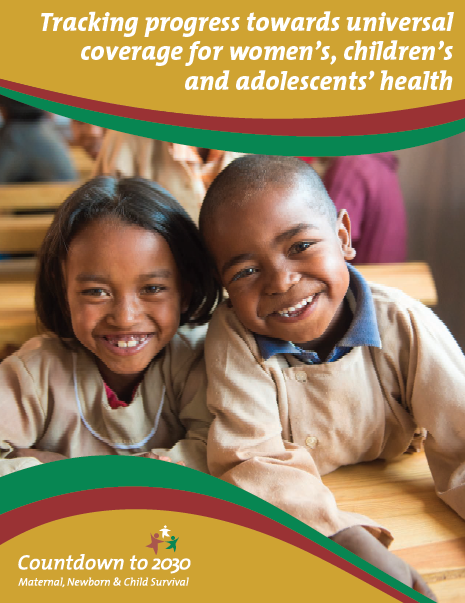United Nations Children’s Fund (UNICEF) and the World Health Organization (WHO)
Published online: February 2018
ISBN: 978-92-806-4921-5
Countdown to 2030 tracks coverage levels for health interventions proven to reduce maternal, newborn and child mortality. It calls on governments and development partners to be accountable, identifies knowledge gaps, and proposes new actions to achieve universal coverage for women’s, children’s and adolescents’ health.
This is the first Countdown to 2030 report in the context of the 2030 agenda for sustainable development and the Every Woman Every Child Global Strategy for Women’s, Children’s and Adolescent’s Health (2016–2030). It synthesizes data on the current situation and trends in reproductive, maternal, newborn and child health and nutrition from a wide array of sources including the profiles on the 81 Countdown priority countries, which together account for 95% of maternal deaths and 90% of deaths among children under age 5…
In September 2015 the UN General Assembly adopted the Sustainable Development Goal framework, which specifies 17 global goals and 169 targets to be achieved by 2030, along with 230 indicators for monitoring progress.1 Sustainable Development Goal 3 (ensure healthy lives and promote well-being for all at all ages) is dedicated to health and includes 13 targets. Health-related targets are also interspersed throughout the other 16 goals—for example, ending malnutrition, part of Sustainable Development Goal 2. The Sustainable Development Goal framework positions health and well-being as foundational to economic and social development and environmental protection. It emphasizes reaching universal health coverage and addressing social and environmental determinants to reduce inequalities and ensure that no one is left behind. Central to achieving this are an enabling environment and resilient health systems that can deliver high-quality services to all women and children.
Countdown tracks inequalities in individual interventions for reproductive, maternal, newborn and child health and through the well-tested composite coverage index, which cuts across four intervention areas. Wealth-related and urban– rural inequalities in the composite coverage index are falling in most Countdown countries, yet variations persist. Some countries, such as Angola and Nigeria, have massive inequalities between rich and poor people, while others, such as Malawi, Swaziland and Turkmenistan, have almost none. Data on within-country inequality across geographic regions, which is very large in several Countdown countries, also provide critical information for programmatic action.
Countdown’s five priority areas of action are:
- Publishing independent high-quality comprehensive analyses of progress towards the Sustainable Development Goals that are related to reproductive, maternal, newborn, child and adolescent health and nutrition—with a focus on coverage and equity of cost-effective interventions for the main causes of maternal and child deaths.
- Providing analytic inputs to progress reports towards the Global Strategy for Women’s, Children’s and Adolescents’ Health (2016–2030); reports prepared by the Independent Accountability Panel; global efforts to monitor nutrition, adolescent health and early childhood development; and other global and regional reports.
- Improving the measurement of coverage of interventions, including more and better disaggregation of available data and quality of care. Improving the measurement and analyses of key drivers of intervention coverage, such as governance, civil society representation and conflict settings.
• Strengthening regional and country analytical capacity to collect, analyse and use data for accountability for women’s, children’s and adolescents’ health in the context of the Sustainable Development Goals and universal health coverage
Full Report, including the 81 priority country profiles – click here or access the dynamic platform / Acceda al informe completo incluyendo los 81 perfiles de los países prioritarios – clic aquí, o acceda a la plataforma dinámica (texto y plataforma en inglés solamente).
The author/source alone is responsible for the views expressed in this article/publication or information resource, and they do not necessarily represent the positions,decisions or policies of the Pan American Health Organization. = El autor/fuente es el único responsable por las opiniones expresadas en este artículo/publicación o recurso de información y no necesariamente representan las posiciones, decisiones o políticas de la Organización Panamericana de la Salud.








